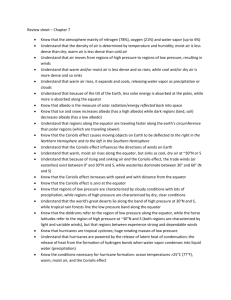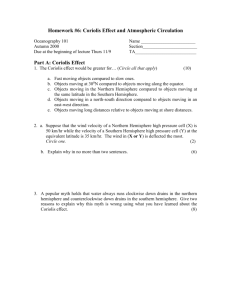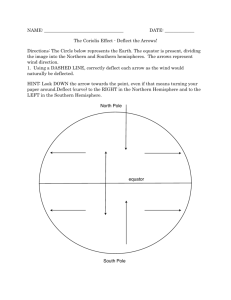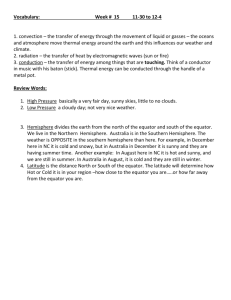Coriolis Effect Lab: Marine Science Activity
advertisement
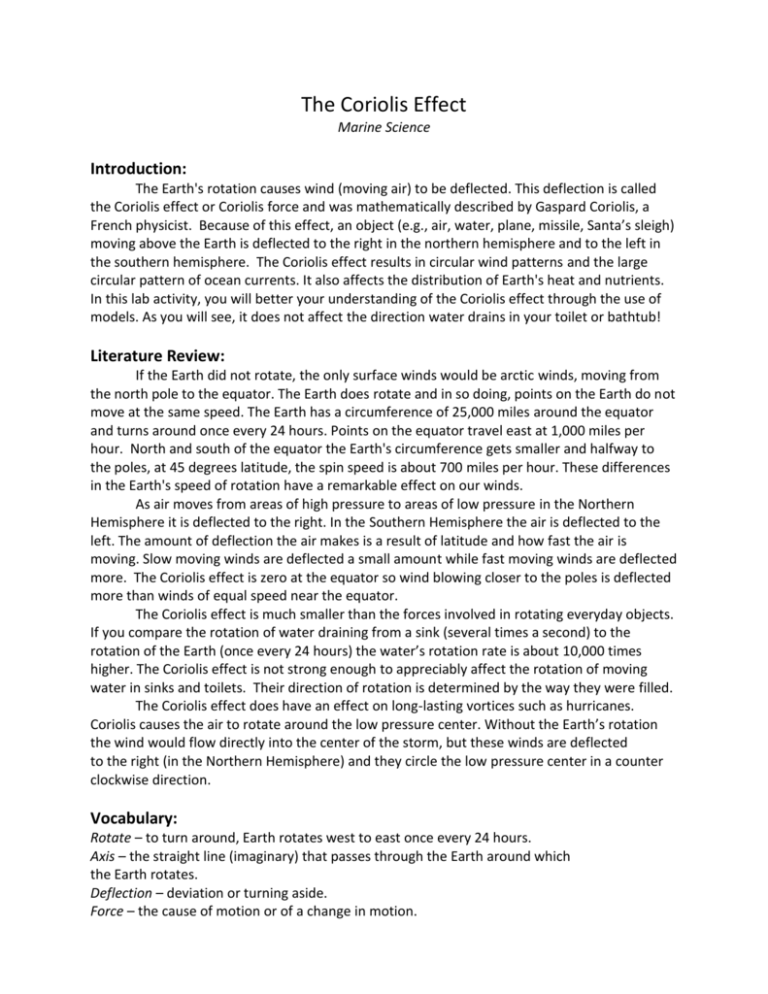
The Coriolis Effect Marine Science Introduction: The Earth's rotation causes wind (moving air) to be deflected. This deflection is called the Coriolis effect or Coriolis force and was mathematically described by Gaspard Coriolis, a French physicist. Because of this effect, an object (e.g., air, water, plane, missile, Santa’s sleigh) moving above the Earth is deflected to the right in the northern hemisphere and to the left in the southern hemisphere. The Coriolis effect results in circular wind patterns and the large circular pattern of ocean currents. It also affects the distribution of Earth's heat and nutrients. In this lab activity, you will better your understanding of the Coriolis effect through the use of models. As you will see, it does not affect the direction water drains in your toilet or bathtub! Literature Review: If the Earth did not rotate, the only surface winds would be arctic winds, moving from the north pole to the equator. The Earth does rotate and in so doing, points on the Earth do not move at the same speed. The Earth has a circumference of 25,000 miles around the equator and turns around once every 24 hours. Points on the equator travel east at 1,000 miles per hour. North and south of the equator the Earth's circumference gets smaller and halfway to the poles, at 45 degrees latitude, the spin speed is about 700 miles per hour. These differences in the Earth's speed of rotation have a remarkable effect on our winds. As air moves from areas of high pressure to areas of low pressure in the Northern Hemisphere it is deflected to the right. In the Southern Hemisphere the air is deflected to the left. The amount of deflection the air makes is a result of latitude and how fast the air is moving. Slow moving winds are deflected a small amount while fast moving winds are deflected more. The Coriolis effect is zero at the equator so wind blowing closer to the poles is deflected more than winds of equal speed near the equator. The Coriolis effect is much smaller than the forces involved in rotating everyday objects. If you compare the rotation of water draining from a sink (several times a second) to the rotation of the Earth (once every 24 hours) the water’s rotation rate is about 10,000 times higher. The Coriolis effect is not strong enough to appreciably affect the rotation of moving water in sinks and toilets. Their direction of rotation is determined by the way they were filled. The Coriolis effect does have an effect on long-lasting vortices such as hurricanes. Coriolis causes the air to rotate around the low pressure center. Without the Earth’s rotation the wind would flow directly into the center of the storm, but these winds are deflected to the right (in the Northern Hemisphere) and they circle the low pressure center in a counter clockwise direction. Vocabulary: Rotate – to turn around, Earth rotates west to east once every 24 hours. Axis – the straight line (imaginary) that passes through the Earth around which the Earth rotates. Deflection – deviation or turning aside. Force – the cause of motion or of a change in motion. Part I Spinner Procedure: You will need construction paper, a pencil, a piece of string 7.5 cm long, scissors, a ruler, an eyedropper, and water. 1. Fold a sheet of construction paper in half. 2. Measure a length along the crease of approximately 15 cm. 3. Mark the middle of the 15 cm length with a pencil. 4. Place one end of the string at this mark and hold it there with your finger. (You will use the string as a compass). 5. Draw an arc using the other end of the string as a guide for your pencil (pulling the string tight and sweeping it around as you mark). 6. You should have a half circle drawn on the folded construction paper. 7. Cut through the folded paper so that a circle is created when you unfold it. 8. Push the point of a pencil through the center of the circle (it is already marked). 9. Place a drop of water on top of the paper near the pencil. 10. Hold the pencil in between your hands and spin it in a clockwise (right) direction. Record observations. (draw the circle indicating its spin direction and the direction of the water droplet) 11. Take the paper off the pencil, turn it over and put it back on the pencil so that you have a dry surface for the second test. 12. Place a drop of water on top of the paper near the pencil. 13. Spin it again but this time counterclockwise (left). Record observations. Observations: Describe what you observed when you turned the spinner clockwise and counterclockwise. Which direction did the drop travel compared to the motion of the spinner? Use words and a diagram. Clockwise spin (spin to the right) Counterclockwise spin (spin to the left) Part II Global Connections Procedure: You will need a large sphere. The globe, the blow-up globe, or a basketball will work for this activity. 1. Spin the globe to the right when facing it. This is the direction the earth rotates (counterclockwise from the perspective of the Northern Hemisphere). 2. As the world turns, have a partner draw a line using a vis a vis pen (do not use permanent marker) from the North Pole to the Equator. 3. Observe and draw the line in the data section. 4. Now repeat steps 1 through 3 except start the line at the South Pole and draw it to the equator. 5. Observe and draw line in the data section. 5. Clean the pen mark off the globe with the rubbing alcohol. Northern Hemisphere Southern Hemisphere North Pole Equator Equator South Pole Questions: 1. Describe what you observed when the line was drawn on the rotating globe. Instead of straight to the equator which compass directions (N, S, E or W) did the lines follow in each hemisphere? 2. The Coriolis Effect states that all objects traveling in the northern hemisphere will veer to the right and all objects traveling in the southern hemisphere will veer to the left. We saw this demonstrated on the large sphere when we drew a line from the pole towards the equator. However, if you draw a line coming from the equator towards the North Pole the same way we did with the line coming down from the North pole it will appear to veer to the left instead of the right as it goes towards the North Pole. How do you explain this discrepancy? And what aspect are we missing in our model? Spinner 3. During the Spinner part of this lab, why did the drop of water move in the opposite direction to the spinner? 4. What real world phenomenon with regards to water and air movement is this simulating? 5. What is the name given to this phenomenon? Global Connections 6. What type of air mass might the pen lines represent? 7. Why would these air masses be traveling south in the Northern Hemisphere and north in the Southern Hemisphere? 8. Describe the path of these two air masses and why they take these paths. Coriolis Questions 9. Describe how the Coriolis Effect would work on a cannon ball if it was fired from the North Pole towards a target at the equator. (draw a diagram) 10. Which direction (left or right) would you need to aim the cannon in order for it to hit the target? 11. Now describe how the Coriolis Effect would work on a cannon ball fired in the opposite direction, from the Equator to the North Pole. 12. Which direction (left or right) would you need to aim the cannon at the Equator in order for it to hit its target?



